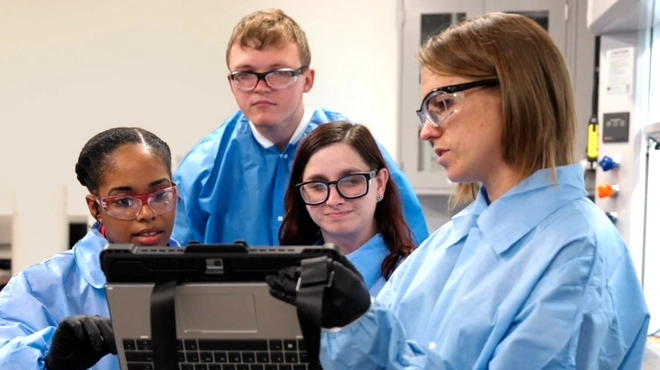Humans carrying a certain rare combination of two genetic mutations experience something unexpected. One mutation causes sickle cell disease, a lifelong and debilitating form of anemia that affects millions worldwide. The other appears to cancel out the first. Individuals with both mutations show no symptoms of disease.
Hematologist Stuart Orkin and other experts in the field think that the second mutation might be a key to finding a new approach to treating patients with sickle cell disease. There are many possible ways to transform that idea into an actual therapy, but Orkin – an investigator of the Howard Hughes Medical Institute who has studied the protein affected in sickle cell disease for decades – has a particular goal in mind. He wants to develop a pill that will correct the anemia of sickle cell disease. Such a therapy could be used by patients around the world, including those in resource-poor regions where the disease is most prevalent.
To create a pill for the treatment of sickle cell anemia, Orkin’s academic research group at Dana-Farber/Boston Children’s Cancer and Blood Disorders Center in the US has teamed up with researchers at the Novartis Institutes for BioMedical Research (NIBR). This arrangement is part of a larger strategy to accelerate the discovery and development of new medicines by closely collaborating with the world’s leading academic experts.
“We’ve always gone to the academic experts in a field to allow Novartis to hit the ground running on projects,” says Susan Stevenson, a NIBR director who is working with Orkin on hematology research. “Now we’ve developed the Faculty of Scholars, which is a framework for these mutually beneficial collaborations.”
A vision for accessible medicine
Sickle cell disease is caused by a single mutation in the gene that encodes one-half of hemoglobin, the oxygen-carrying protein of red blood cells. The mutant protein distorts the shape of red blood cells and leads to sickle-shaped cells that have a short half-life and also get stuck in small blood vessels.
Patients have anemia, pain, organ damage, and an increased risk of infections and stroke. Current management includes the use of an old chemotherapy drug, hydroxyurea, which is beneficial to many (but not all) patients and requires careful monitoring.
The disease is more common in people of African, South American, Indian, and Middle Eastern descent. In sub-Saharan Africa, only one in five children born with the disease will survive to adulthood, even with access to health care. Without health care nearby, the mortality rate is estimated to be as high as 90%.
Decades ago, researchers recognized the role of a disease-canceling mutation seen in patients with the sickle cell mutation but no signs of disease. The second mutation allows the body to continue producing fetal hemoglobin, the principal oxygen-carrying molecule in the developing fetus. A few weeks after birth, the body puts the brakes on its production, allowing adult hemoglobin to take over.
Orkin’s academic laboratory discovered the genetic switch that stops fetal hemoglobin production. The discovery opened the door to disrupting the switch, allowing the production of fetal hemoglobin to continue after birth and into adulthood, potentially dampening the effects of sickle cell disease.
The challenge is that the switch that turns fetal hemoglobin off, a protein called BCL11A, is difficult to disrupt. Drug hunters typically search for small molecules that fit into a pocket on a protein’s surface and jam up its mechanics to block its activity. But BCL11A doesn’t have an obvious pocket to jam up.
As a result, Orkin and the other researchers aiming to cure sickle cell disease need to think creatively and consider new ways to interfere with the action of BCL11A. Indeed, one of Orkin’s academic colleagues at Dana-Farber/Boston Children’s Cancer and Blood Disorders Center has designed gene therapy for sickle cell disease based on reducing the level of BCL11A. This approach, which is being tested in a clinical trial, requires hospitalization and sophisticated medical care.
Orkin, however, still seeks to develop a small molecule drug that will inhibit BCL11A, despite the challenges, because small molecules can be packaged as pills and distributed globally. In the pursuit of this objective, he now has access to the tools and medicinal chemistry expertise at NIBR.
“It’s a very tough problem, but we are taking an innovative approach to tackling the challenges presented by this disease,” says Orkin, who is also the David G. Nathan distinguished professor of pediatrics at Harvard Medical School in the US.
Better science together
NIBR scientist Craig Mickanin’s group has teamed up with Orkin to try to find a way to block BCL11A with a small molecule. “We love working with Stuart because he brings so much constructive energy and disease expertise to the table,” says Mickanin, a director in NIBR’s Chemical Biology and Therapeutics group.
Rather than disrupting the protein’s activity by jamming up its works, Mickanin’s team is aiming to send BCL11A to the cell’s garbage disposal, a therapeutic approach called targeted protein degradation. Every cell has a built-in garbage disposal that consumes and recycles proteins that have been marked as trash. A small molecule able to flag BCL11A as garbage could effectively remove the protein before it has a chance to switch fetal hemoglobin off.
As part of this effort, Mickanin, Orkin and the team are mining the breadth of NIBR’s libraries of unique compounds for small molecules that have potential value as therapeutics for sickle cell disease. These libraries include not only the 1 million-plus compounds in their traditional compound library, but also next-generation compound libraries that increase by a thousandfold the diversity of the small molecules Orkin can explore.
The collaborative team also aims to apply innovative techniques for screening these massive libraries to look for hits, particularly using means of rapidly determining whether a small molecule in a library sticks to BCL11A. If they find a molecule that sticks, that would be a first step toward being able to tag BCL11A for disposal.
“It’s a real interesting collaboration that gives us many more opportunities to find potential drugs that work,” says Mickanin.
Main image: Novartis scientists Craig Mickanin and Susan Stevenson work side-by-side with Stuart Orkin (center), a sickle cell anemia scholar with decades of experience studying the disease in his academic lab at Dana-Farber/Boston Children’s Cancer and Blood Disorders Center. Photo by PJ Kaszas.
Learn how Novartis is teaming up with leading academic experts to help discover medicines.



